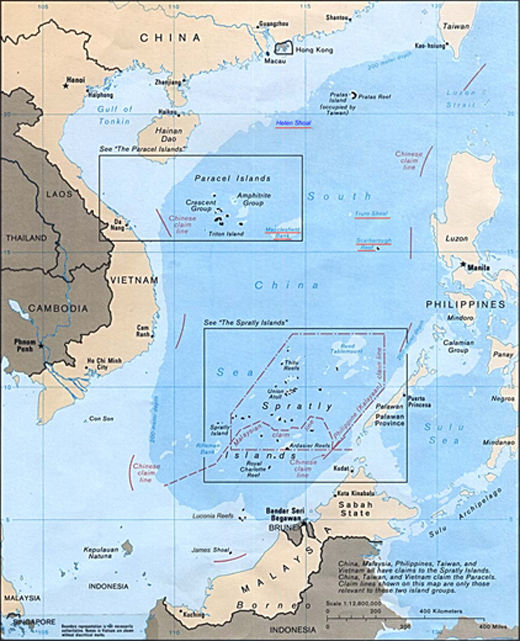
A collection of islands that China has occupied off the Vietnam coast has created great tension between the two countries. The islands in dispute include the Paracels and Spratlys. These are islands over which Vietnam, among other states in the area, claims sovereignty rights. The South China Sea dispute involves the interest of Vietnam, particularly with regard to freedom of navigation, international laws, and the bilateral relations with other regional governments—most significantly, China.
The South China Sea encompasses several hundred small islands, atolls, rocks, and shoals. Most of the islands have no population. China has laid claim to much of this area in the South China Sea. However regional powers including Brunei, the Philippines, Taiwan, and Vietnam also claim territorial rights in the same area. As a result of this territorial dispute, the China-Vietnam relationship has entered a period of conflict and Vietnam remains nervous over expectations of the peaceful resolution of the dispute.
China is unilaterally staking its claim to the islands by moving military gear into the area. It has been dredging the sea bottom and has built a 10,000-foot runway on one of the islands that it developed. China claims “indisputable sovereignty” over the territory.
It should be understood that this is considered one of the most vital shipping lanes in the world. The South China Sea is also critically important to both global trade and to China’s continuing development. China’s argument is that it has no intention to militarize the region. It claims it has no reason to disrupt one of its own crucial arteries of trade. This remains to be seen.
In addition, the response of the United States has increased this tension. According to the Times, the Stennis Carrier Strike Group is patrolling in the South China Sea. One carrier has conducted flight operations, training and is working with the military forces of regional allies like the Philippines. The U.S.’ interference only makes the issue more complex.
A show of force with expanded naval exercises only raises tensions and increases the danger of military escalation.
The Stennis Strike Group is accompanied by the guided missile cruisers, USS Antietam and USS Mobile Bay, as well as the guided missile destroyers USS Stockdale and USS Chung-Hoon.
There is no doubt that China is challenging the hegemony that the U.S. has enjoyed in the East Asian Seas since World War II. In response, the U.S. has encouraged countries in the region, including Vietnam, to conduct regular freedom-of-navigation operations near the islands claimed by China, ostensibly to make it clear that they don’t accept China’s territorial claims.
These competing claims of sovereignty make the South China Sea dispute potentially explosive.
China claims it supports the right to “freedom of navigation,” but also affirms that Beijing does not accept any sovereignty infringements. Vietnam believes that China’s construction of an airfield on one of the atolls that Beijing turned into an island in 2014, however, is a direct violation of its sovereignty rights.
Unfortunately, the American public has little knowledge of the events taking place in this part of the world, as the South China Sea disputes have received inadequate coverage in much of the media. But with economic interests at stake, and both China and the U.S. asserting the right to protect exclusive zones, the chance of a military confrontation increases with each passing day.
Photo: Map of the South China Sea. By U.S. Central Intelligence Agency – Asia Maps – Perry-Castañeda Map Collection: South China Sea (Islands) 1988, Public Domain.












Comments